September 3, 2023
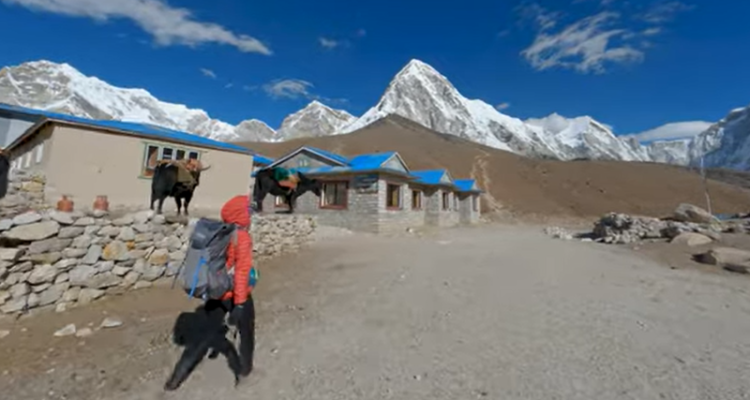
Embarking on a journey to Everest Base Camp is a lifelong aspiration for many adventure enthusiasts. However, the Himalayan weather, characterized by its extreme variations, can either make or break this iconic trekking experience. Understanding the monthly weather patterns is essential to plan a safe and enjoyable adventure.
In the heart of winter, January and February bring frigid temperatures, with the mercury plummeting well below freezing. It’s a season for the most intrepid trekkers who can brave the extreme cold. March brings a slight reprieve as temperatures slowly rise, making it a more manageable time to trek. As April arrives, the trekking season begins in earnest, offering more bearable daytime temperatures and heralding the start of rhododendron blooms. With May comes milder weather and the enchanting sight of wildflowers blanketing the landscape. However, trekkers must be prepared for changing conditions, as the Everest region’s weather can be as capricious as it is awe-inspiring.
In January, Everest Base Camp experiences extremely cold and harsh weather conditions due to its high altitude in the Himalayas. It is not a popular trekking season because of the severe cold, limited visibility, and the risk of avalanches. Here’s what you can generally expect in terms of weather at Everest Base Camp in January:
Temperature: Daytime temperatures at Everest Base Camp in January can range from -10°C to -20°C (14°F to -4°F). Nighttime temperatures can plummet even further, often dropping below -20°C (-4°F) and occasionally reaching as low as -30°C (-22°F).
Precipitation: January is a dry month in the Everest region. While there may be occasional snowfall, the overall precipitation is minimal. The ground is often covered in snow and ice.
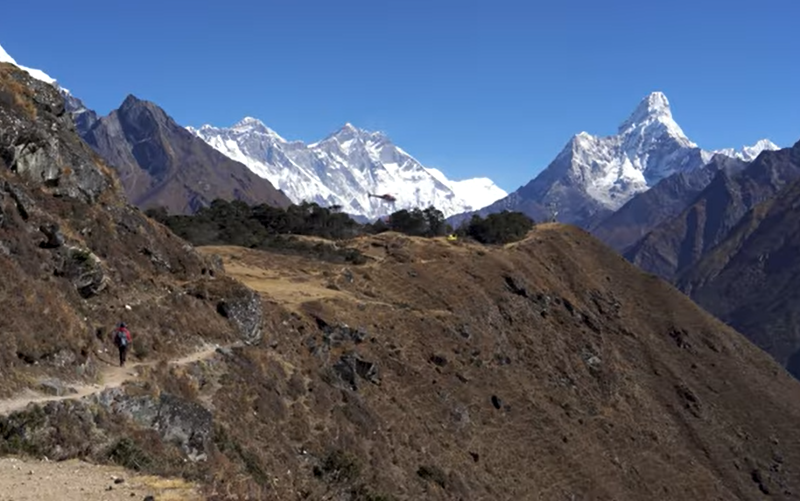
Namche Bazaar to Tengboche trails with View of Ama Dablam Muntain
Snow and Ice: The trails leading to Everest Base Camp are covered in snow and ice in January, making trekking conditions extremely challenging. You will need appropriate gear, including crampons and warm clothing, to navigate these icy paths.
Limited Visibility: Due to the cold and snowy conditions, visibility can be limited. Clouds and fog may obscure the breathtaking mountain views that trekkers usually seek.
Few Trekkers: January is considered the off-peak season for trekking to Everest Base Camp because of the harsh weather conditions. Consequently, you will encounter far fewer trekkers on the trails and in the teahouses along the way.
Risk of Avalanches: January is a risky time for avalanches in the Everest region. The accumulation of snow on steep slopes can increase the risk of avalanches, so it’s essential to stay informed about current conditions and follow safety precautions.
Trekking to Everest Base Camp in January is only recommended for experienced trekkers who are well-prepared for extreme cold and have appropriate gear. It’s crucial to have a Experienced guide who is familiar with the terrain and conditions during this challenging time of year. Additionally, always check the latest weather and trail conditions before embarking on your journey, and be prepared for the possibility of itinerary changes due to inclement weather.

February marks the heart of winter at Everest Base Camp. During this month, daytime temperatures hover in the range of -10°C to -15°C (14°F to 5°F), and nighttime temperatures plummet even further, often dropping below -20°C (-4°F). The trails are blanketed in a thick layer of snow and ice, making trekking conditions exceedingly challenging. Trekkers need to equip themselves with crampons and cold-weather gear to navigate the icy terrain. Visibility can be limited due to persistent clouds and fog. Trekking in February is best suited for seasoned adventurers who are prepared for extreme cold and adverse weather conditions.
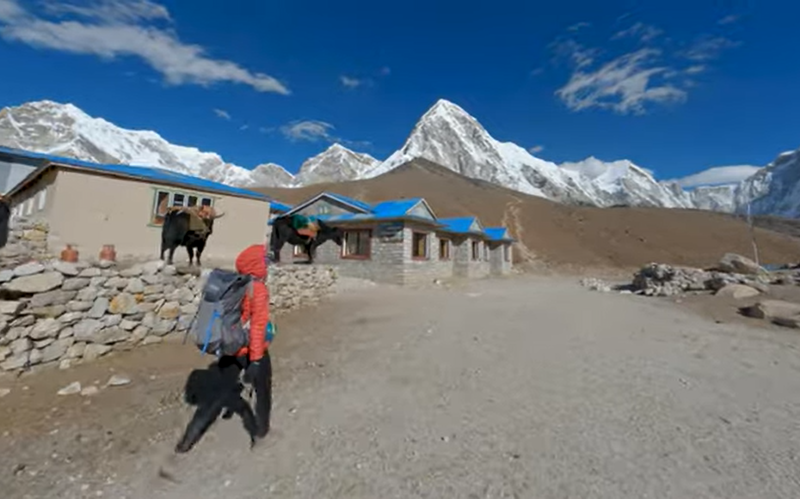
Beautiful Gorakshep -the last settlements of EBC Trek
March signifies the gradual transition from winter to spring in the Everest region. Daytime temperatures see a slight increase, ranging from -5°C to -10°C (23°F to 14°F), while nighttime temperatures remain cold, often around -15°C (5°F). As the month progresses, snow and ice start to melt, rendering the trails less icy but still challenging. Visibility tends to improve, offering trekkers better glimpses of the stunning mountain vistas. March is a transitional period, and conditions can fluctuate, so being prepared for changing weather is crucial.
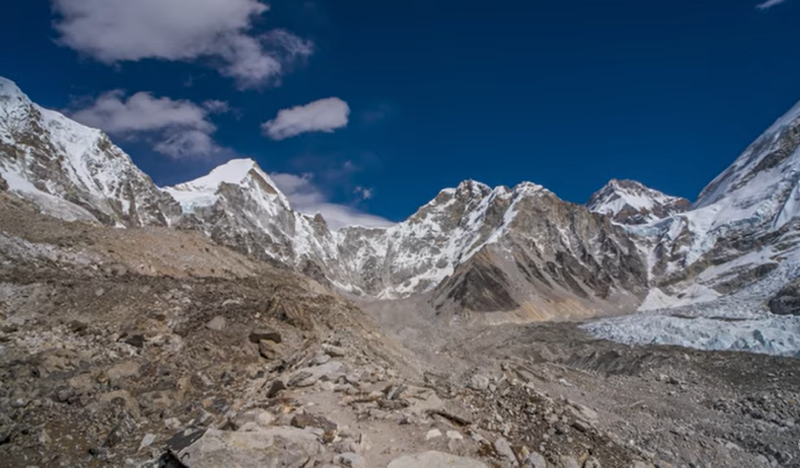
Everest Base Camp -5364m
April ushers in the trekking peak season at Everest Base Camp. Daytime temperatures become notably milder, with a range of 0°C to 10°C (32°F to 50°F), while nighttime temperatures are generally above freezing. The trails continue to clear of snow and ice, making trekking more manageable. Trekkers can relish in the excellent visibility, which provides unobstructed views of the magnificent Himalayan peaks. April is widely considered one of the best months for trekking to Everest Base Camp, boasting comfortable temperatures and clear skies.
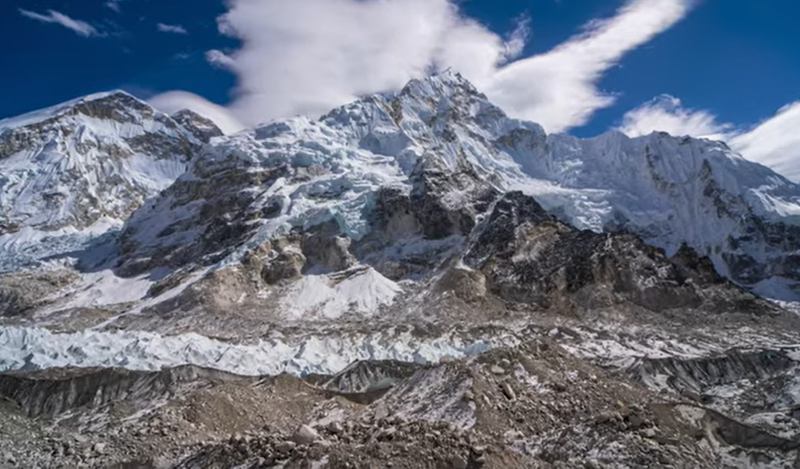
Khumbu icefall, Glacier view from Base Of Mount Everest
May is another exceptional month for trekking in the Everest region. Daytime temperatures become even more comfortable, typically ranging from 5°C to 15°C (41°F to 59°F). The trails are mostly free of snow and ice, significantly easing trekking conditions. Crystal-clear skies offer trekkers awe-inspiring mountain panoramas. May represents the peak of the trekking season, offering ideal conditions for those seeking to experience the beauty of Everest Base Camp.
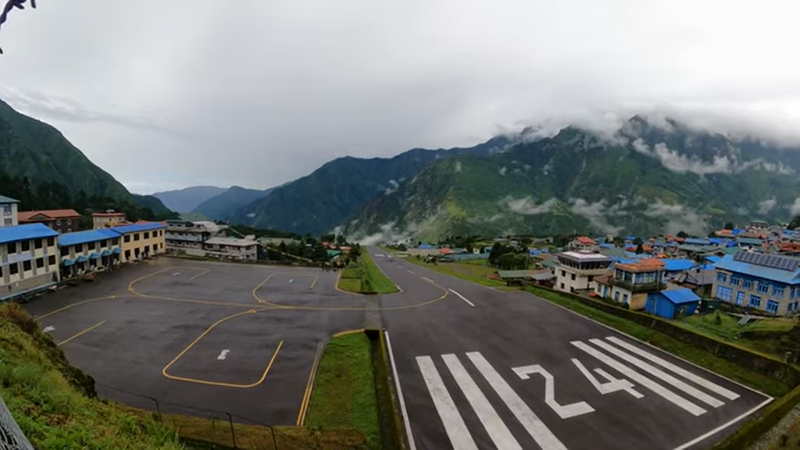
Lukla airport in June -Monsoon time
Trekking to Everest Base Camp in June comes with significant challenges due to the monsoon season. Weather conditions include daytime temperatures ranging from 15°C to 20°C (59°F to 68°F). However, heavy rainfall is a defining feature, with frequent downpours, especially in the afternoons and evenings. Trails become muddy and slippery, demanding sturdy footwear. Landslide risks rise due to the saturated terrain. Persistent cloud cover can limit mountain views. Trekking in June requires preparedness for wet and challenging conditions, with safety precautions against landslides, making it less popular than other seasons. Adventurous trekkers should plan for the unique experience while being aware of the weather’s unpredictability.
July falls within the heart of the monsoon season at Everest Base Camp. During this month, daytime temperatures range from 15°C to 20°C (59°F to 68°F). While temperatures are relatively mild, this period is characterized by heavy rainfall. Continuous rain makes trekking strenuous and potentially hazardous. The trails often turn into muddy quagmires, making footing unstable and slippery. Moreover, there is an increased risk of landslides due to the saturated terrain. The heavy precipitation also obscures mountain views, making this an unfavorable time for trekking. Trekkers typically avoid July due to the adverse weather conditions.
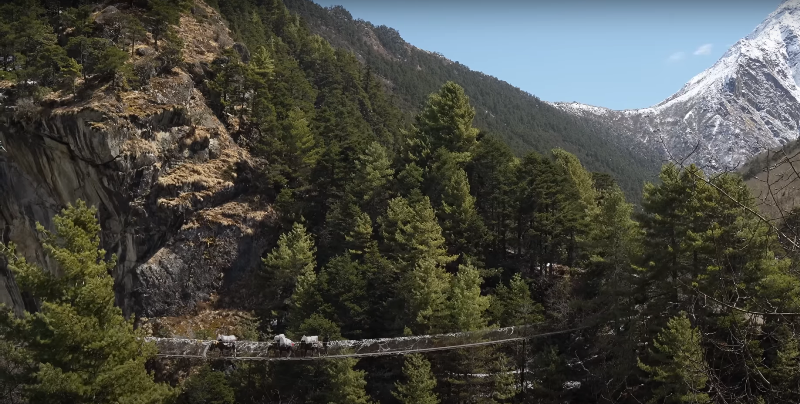
Suspension bridge at Jorsalle-2820m-EBC Trek
August is another monsoon month, featuring similar weather patterns as July. Daytime temperatures remain in the range of 15°C to 20°C (59°F to 68°F). Rainfall persists, and the trails continue to be muddy and slippery, increasing the risk of accidents. Landslides are also a concern. The heavy precipitation during this time can obscure mountain vistas, diminishing the overall trekking experience. Trekkers generally avoid August due to the unfavorable conditions and safety concerns on the trails.
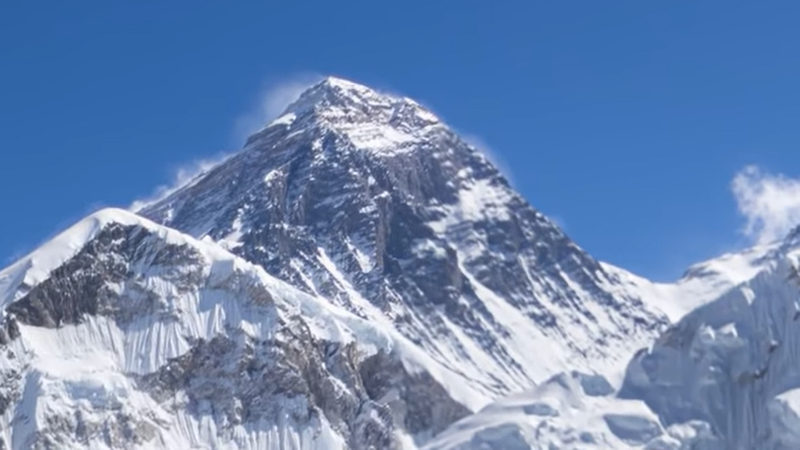
Mount Everest view from Kalapathar-5550m
September marks the end of the monsoon season in the Everest region. As the month progresses, the weather gradually improves. Daytime temperatures range from 5°C to 15°C (41°F to 59°F). While it can still be damp early in the month, the trails start to dry out. Trekkers can anticipate better trekking conditions compared to July and August, but it’s important to be prepared for some residual mud on the trails. Clearing skies and improved visibility make September a transitional period into the favorable autumn trekking season. It’s a time when trekkers can begin considering their Everest Base Camp adventures again as conditions become more suitable.
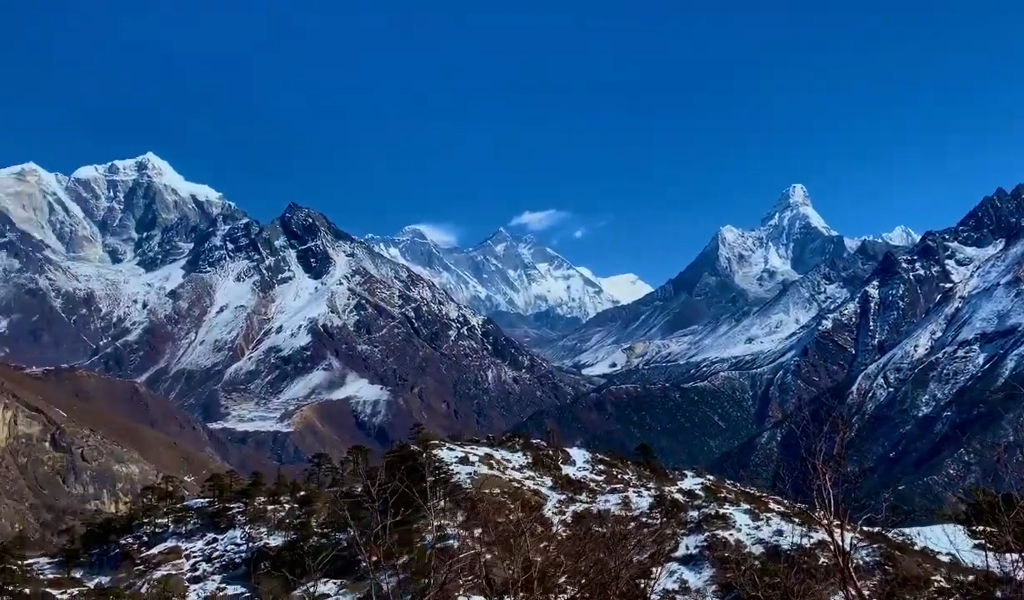
Snowy view pf Mt. Everest and others from Everest view Hotel Above Namche bazaar
October is a highly favored month for trekking to Everest Base Camp. During this time, the weather at Everest Base Camp is generally pleasant. Daytime temperatures typically range from 5°C to 15°C (41°F to 59°F) early in the month, gradually cooling to 0°C to 10°C (32°F to 50°F) toward the end of October. Nights can be chilly, with temperatures dropping to -5°C to -10°C (23°F to 14°F). Most of the snow and ice from the previous winter and monsoon seasons have melted, creating more manageable trekking conditions. Clear skies and excellent visibility are common, allowing trekkers to savor breathtaking views of the Himalayan peaks, including the majestic Mount Everest. October is considered the prime trekking season in the Everest region, with dry trails, comfortable weather, and vibrant landscapes, making it ideal for trekkers of all experience levels.
November continues the favorable trekking conditions at Everest Base Camp, although temperatures gradually decrease as the month progresses. Daytime temperatures generally range from 0°C to 10°C (32°F to 50°F) at the beginning of November, but they can drop to -5°C to 5°C (23°F to 41°F) toward the end of the month. Nights become notably colder, often dipping below freezing. While the trails remain mostly free of snow and ice early in the month, some snow accumulation can occur, especially at higher elevations, as November progresses. Nevertheless, trekking during this month is far less challenging than during the harsh winter months. Clear skies and excellent visibility persist, providing trekkers with stunning mountain vistas. November remains a highly suitable time for trekking to Everest Base Camp, with dry trails and generally comfortable weather. It offers an excellent opportunity to experience the beauty of the Everest region with fewer crowds compared to October.

Misty Weather in EBC during end of December
December heralds the return of winter conditions to Everest Base Camp-5,364m. Daytime temperatures drop to -10°C to -20°C (14°F to -4°F), and nighttime temperatures can plummet even further, often falling below -20°C (-4°F). The trails are blanketed in snow and ice, and visibility may be limited due to clouds and fog. Trekking in December is best suited for experienced trekkers who are well-prepared for extreme cold and challenging terrain.
Similar topics about Everest region trek- Information: